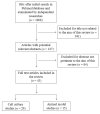Docosahexaenoic Acid as Master Regulator of Cellular Antioxidant Defenses: A Systematic Review
- PMID: 37372014
- PMCID: PMC10295041
- DOI: 10.3390/antiox12061283
Docosahexaenoic Acid as Master Regulator of Cellular Antioxidant Defenses: A Systematic Review
Abstract
Docosahexaenoic acid (DHA) is a polyunsaturated fatty acid that benefits the prevention of chronic diseases. Due to its high unsaturation, DHA is vulnerable to free radical oxidation, resulting in several unfavorable effects, including producing hazardous metabolites. However, in vitro and in vivo investigations suggest that the relationship between the chemical structure of DHA and its susceptibility to oxidation may not be as clear-cut as previously thought. Organisms have developed a balanced system of antioxidants to counteract the overproduction of oxidants, and the nuclear factor erythroid 2-related factor 2 (Nrf2) is the key transcription factor identified for transmitting the inducer signal to the antioxidant response element. Thus, DHA might preserve the cellular redox status promoting the transcriptional regulation of cellular antioxidants through Nrf2 activation. Here, we systematically summarize the research on the possible role of DHA in controlling cellular antioxidant enzymes. After the screening process, 43 records were selected and included in this review. Specifically, 29 studies related to the effects of DHA in cell cultures and 15 studies concerned the effects of consumption or treatment with DHA in animal. Despite DHA's promising and encouraging effects at modulating the cellular antioxidant response in vitro/in vivo, some differences observed among the reviewed studies may be accounted for by the different experimental conditions adopted, including the time of supplementation/treatment, DHA concentration, and cell culture/tissue model. Moreover, this review offers potential molecular explanations for how DHA controls cellular antioxidant defenses, including involvement of transcription factors and the redox signaling pathway.
Keywords: Nrf2; antioxidants; docosahexaenoic acid.
Conflict of interest statement
The authors declare no conflict of interest.
Figures


Similar articles
-
Astaxanthin and omega-3 fatty acids individually and in combination protect against oxidative stress via the Nrf2-ARE pathway.Food Chem Toxicol. 2013 Dec;62:869-75. doi: 10.1016/j.fct.2013.10.023. Epub 2013 Oct 21. Food Chem Toxicol. 2013. PMID: 24157545
-
Characterization of docosahexaenoic acid (DHA)-induced heme oxygenase-1 (HO-1) expression in human cancer cells: the importance of enhanced BTB and CNC homology 1 (Bach1) degradation.J Nutr Biochem. 2014 May;25(5):515-25. doi: 10.1016/j.jnutbio.2013.12.011. Epub 2014 Feb 4. J Nutr Biochem. 2014. PMID: 24613086 Free PMC article.
-
4-Hydroxy hexenal derived from docosahexaenoic acid protects endothelial cells via Nrf2 activation.PLoS One. 2013 Jul 23;8(7):e69415. doi: 10.1371/journal.pone.0069415. Print 2013. PLoS One. 2013. PMID: 23936010 Free PMC article.
-
DHA and Its Elaborated Modulation of Antioxidant Defenses of the Brain: Implications in Aging and AD Neurodegeneration.Antioxidants (Basel). 2021 Jun 3;10(6):907. doi: 10.3390/antiox10060907. Antioxidants (Basel). 2021. PMID: 34205196 Free PMC article. Review.
-
Regulation of the Nrf2 antioxidant pathway by microRNAs: New players in micromanaging redox homeostasis.Free Radic Biol Med. 2013 Sep;64:4-11. doi: 10.1016/j.freeradbiomed.2013.07.025. Epub 2013 Jul 21. Free Radic Biol Med. 2013. PMID: 23880293 Review.
Cited by
-
Age-Dependent Changes in Nrf2/Keap1 and Target Antioxidant Protein Expression Correlate to Lipoxidative Adducts, and Are Modulated by Dietary N-3 LCPUFA in the Hippocampus of Mice.Antioxidants (Basel). 2024 Feb 6;13(2):206. doi: 10.3390/antiox13020206. Antioxidants (Basel). 2024. PMID: 38397804 Free PMC article.
-
Broadband Collision-Induced Dissociation Mass Spectrometry Imaging.J Am Soc Mass Spectrom. 2025 Jul 2;36(7):1443-1455. doi: 10.1021/jasms.5c00045. Epub 2025 Jun 19. J Am Soc Mass Spectrom. 2025. PMID: 40534568 Free PMC article.
-
NOD1: a metabolic modulator.Front Endocrinol (Lausanne). 2025 Jan 21;15:1484829. doi: 10.3389/fendo.2024.1484829. eCollection 2024. Front Endocrinol (Lausanne). 2025. PMID: 39906040 Free PMC article. Review.
-
DHA-Triacylglycerol Accumulation in Tacrolimus-Induced Nephrotoxicity Identified by Lipidomic Profiling.Int J Mol Sci. 2025 Aug 5;26(15):7549. doi: 10.3390/ijms26157549. Int J Mol Sci. 2025. PMID: 40806677 Free PMC article.
-
EGR1 regulates oxidative stress and aldosterone production in adrenal cells and aldosterone-producing adenomas.Redox Biol. 2025 Mar;80:103498. doi: 10.1016/j.redox.2025.103498. Epub 2025 Jan 15. Redox Biol. 2025. PMID: 39826326 Free PMC article.
References
Publication types
Grants and funding
LinkOut - more resources
Full Text Sources

